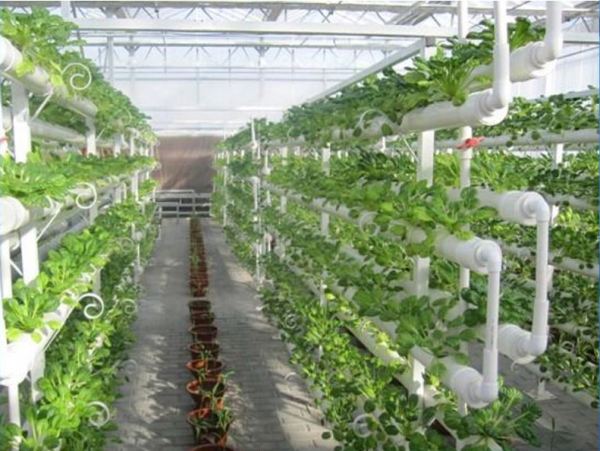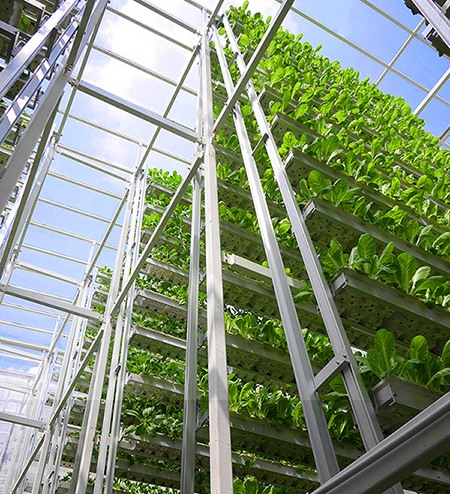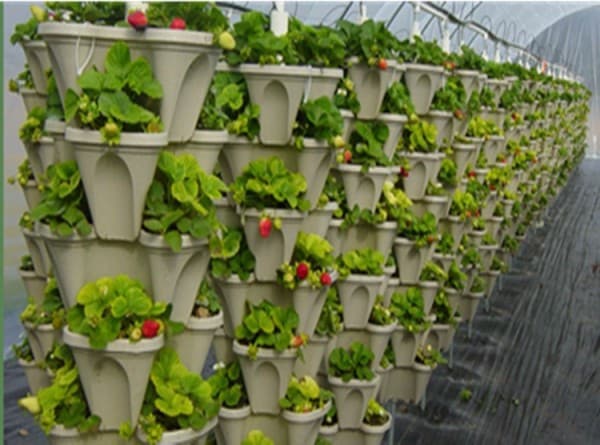Vertical Cultivation For Beginners:
Introduction to Vertical Cultivation:- The world population is increasing at a steady pace. Since the population is growing so the demand for food supply is also rising. To develop more food more land is necessary while prime agricultural lands are getting to be scarce and costly. Agriculture researchers are thinking up new ideas to generate food production and one such researcher Professor Dickson Despommier in 1999 came up with a concept of Vertical Cultivation; this farming utilizes less distance for growing more food. Unlike traditional farming, he also came up with new farming techniques such as Hydroponics and Aeroponics which have high production of food at less space and more yields (which takes less time).
What’s Vertical Cultivation? Vertical Cultivation in easy words is, ‘farms piled (stacked) together with one another unlike traditional flat farming’. We could even specify Vertical Cultivation since the custom of creating food and medication from vertically stacked layers, previously vertically inclined surfaces, or incorporated into various structures. Some farmers or entrepreneurs are starting to employ Vertical Cultivation by utilizing abandoned warehouses, flat rooftops, and lands that are unfertile and futile for farming to make vegetables, fruits, vegetables, and leafy vegetables with high returns. Vertical Cultivation entails growing plants in piled layers reaching a number of stories packed with controlled environments like temperature, light, and nutrition inside. This idea of farming is largely used in small residential houses in Indian urban areas, while to make commercially it needs to be seriously regarded as this brand new farming technologies is growing quickly in developed nations.

Vertical Cultivation is dependent upon the use of various physical procedures to succeed. Combining these devices and technologies in an integrated whole Is Essential to Create Vertical Cultivation a fact. Numerous approaches are suggested and under research. The most Frequent technology suggested are:
- Greenhouse.
- The Folkewall and other vertical growing architectures.
- Flowerpot.
- Hydroponics / Aeroponics / Aquaponics.
- Composting.
- Grow light.
- Phytoremediation.
- SkyScraper.
- Controlled-environment agriculture.
- Precision agriculture.
- Agricultural robot.
Need to Go For Vertical Cultivation:- The population of the world is increasing at a very fast pace particularly in the urban areas. In accordance with the U.N population branch, the entire world population may increase from seven billion dollars to nine and billion by the year 2050. While the population in the urban regions is increasing at an alarming rate and reach 70% by 2050. 80 million people are added to the planet’s population per annum. Agriculture creates is going down because of climate changes along foodborne diseases are increasing. Water distribution to agriculture farming is becoming scarce in many areas. Compounds are failing due to plant pathogens and insect pests. To feed countless mouths we will need to generate enough food with the restricted land, water, and nutrient sources and this is accomplished through Vertical Cultivation technology.

Vertical Cultivation technologies use natural renewable resources to cultivate crops. For instance, many of these crops are grown under artificial sunlight. Various water systems and management are used to pump water through pipelines. On top of the greenhouse or on a skyscraper’s windmill, solar panels have been used for the purpose of producing electricity to generate artificial light and draining water.
Types of Vertical Cultivation:- Vertical farms come in different designs, patterns, and sizes. In developed nations, Vertical Cultivation is done in multi-storied buildings and huge warehouses, therefore, make it simple 2-level or multi-levels or perhaps wall-mounted, Vertical Cultivation could be done based on the dimensions, form, and levels of the accessible place. Basically, all types of vertical farms utilize growing mediums and soil-free growing like hydroponics, aquaponics, or aeroponic systems.
Hydroponic Vertical Cultivation:- This is the most widely growing system employed in Vertical Cultivation. Within this method, the soil is replaced with a growing medium like perlite, coconut fiber, coco peat, Rockwool, gravel, and etc. Plants grow by providing nutrient water into the plant roots. The plant roots are enclosed in a mailbox using a substrate and will be hanging directly into the nutrient water. Roots draw nutrients and water directly from the water or out of water consumed substrates in the containers. The water must be regularly monitored for the correct nutrient composition. Hydroponics is significantly more popular as crops can be cultivated depending on the plant habitat and dimensions. Based on the essence of plants, farming could be done in many types of hydroponic systems like the wick, trickle system, flood and drain, deep water culture, nutrient film technique. The way the different kinds of hydroponic system works are mentioned at Growing Plants In Hydroponics.

Aeroponics Vertical Cultivation:- This system involves growing plants in misting surroundings with no growing medium or soil and hardly any water containing nutrients. Aeroponics systems are something that deviates from the standard or normal hydroponic farming methods from the Vertical Cultivation Earth, yet they are drawing in huge intrigue. An aeroponics system is by a wide margin the most productive plant-developing system for perpendicular cultivation, utilizing something like 90 percent less water than any among the best hydroponic systems. Plants that have been developed in aeroponics systems have likewise been looked to take up more vitamins and minerals, which makes the plants more healthful and conceivably more nutritious.
The plants are introduced inside suspended units which are supplied fundamental supplements for the plants to grow on a timely basis. The societal impacts are amazing giving high harvest yield and quite less risk that helps the entrepreneur over the long haul. How the aeroponics system works is a very simple concept. As there’s typically very little growing network utilized, the roots are totally exposed to the high access to oxygen allowing the plants to grow faster in this kind of system. The plants have been suspended either by net containers using perlite or Rockwool plugs that pack around the plant’s stem. These containers with perlite match to little holes on top of the expanding chamber. The roots hang down freely inside the expanding room where they get sprayed with vitamins and nutrient water from mist nozzle heads periodically. The conventional sprinkling cycles keep the roots moist and from drying out, and moreover provides the nutrients the plants will need to develop.
Aquaponics Vertical Cultivation:- In this system, it’s a growing combination of both fish and plants in the exact same ecosystem. Fish are grown in huge containers, the waste generated by seeds which turn out to nitrates and ammonia for plants growth. The fish waste becomes a fantastic fertilizer for plants and that they suck up these nutrients from the water thus purifying the water that’s delivered back to the massive container in which fish are living. Though, this kind of system is not much widely utilized in Vertical Cultivation as most entrepreneurs focus on producing few fast-growing profitable vegetable crops. Some of the vertical farm entrepreneurs comprise aquaponics but at a smaller scale based on the primary product line. Blend of aquaculture together with hydroponics can lead to higher earnings by utilizing limited distance, attempt, water, and fertilizers.
Plan and Design of Vertical Cultivation System:
- The Shape of Building for Vertical Cultivation: The shape of the construction has a significant part as it ought to get maximum sunlight penetration throughout the day. The asymmetrical high-rise building is much favored as it isn’t hard to plan design and build. Each floor must accommodate six beds with a pathway of approximately 150 to 200 cm for simple movement of equipment from place to place needed for farming.
- Irrigation for Vertical Cultivation: Drip irrigation remains The very best irrigation system that saves water by allowing water to drip slowly directly on the plant root zone. The elements required for water to reach the root canal include — water pump, water filters, fertigation systems, backwash controller, pressure control valve, pipes, and tubing. Liquid fertilizer or nutrients with irrigation water provided through drip irrigation can save as much as 95% in fertilizers. Drip irrigation that’s properly designed, installed, managed, will help to reduce water savings.
- Lighting system for Vertical Cultivation: Lighting can be provided With the natural sunshine system and artificial lighting system. Having a network of Reflectors installed on each floor will enable to use of maximum sunlight During the daytime. By night light can be done with a light-emitting diode system Which is relatively affordable, bright, and long-lasting.
Advantages and Disadvantages of Vertical Cultivation:
Advantages of Vertical Cultivation:
- Continuous Crop Production: An entrepreneur can anticipate harvest production year-round no matter areas, climate, and other environmental conditions. The high quality and production are much more efficient than conventional methods of farming. According to Prof. Despommier, harvest made in 30 acres of open farmland by traditional farming methods can be obtained from an indoor one-acre Vertical Cultivation method, by taking into consideration the number of crops produced in a season.
- Efficient Method: Many farmers and entrepreneurs in developed nations are moving to Vertical Cultivation from traditional farming due to its simple and effortless farming procedures. This farming system is quite efficient and powerful while using less manual farming work with economies such as pesticides and insecticides, herbicides, organic and chemical fertilizers, and weeding. The high quality and yield are extremely high as everything is done in a controlled environment with a rather minimal attack of diseases and pests.
- Weather Requirements: Fruits, vegetables, and herbs have been grown no matter plant habitat as temperatures have been controlled and set to desirable plant healthy growing amounts in a vertical farm system. This is the big advantage in protecting crops and plants from extreme weather conditions.
- Water Utilization and Recycling: Approximately 65% – 75% of water is saved through hydroponic growing techniques in contrast to traditional agriculture farming approaches. About 90% of the water will be saved when using an aeroponics system which involves misting of plant origins. Water wastage is quite minimal making this kind of farming valuable.
In case if you miss this: RAS Business Plan.
Disadvantages of Vertical Cultivation:
- Investment in Land, Building, and Infrastructure: Among the biggest drawbacks in this farming is the high cost it is connected with. As prices of farmlands away from towns is very less compared to urban land and buildings. This can be carried out in abandoned warehouses that could be cheaper but nonetheless, it’s expensive compared with conventional farming expenses. The cost requires the building or warehouse lease amount or purchasing amount will be higher. Setting up a controlled environment, stuff for lying of multi-layer farm beds, and etc. is an immense one-time investment. Some of the hidden costs and defects can be noticed only after running and must be prepared to manage such issues.
- Energy Consumption: Energy intake involves temperature controlling, artificial lighting, water pumping, etc., add to operational costs. Solar renewable energy is a one-time investment that can reduce a lot of the recurring huge bills. Although, the entrepreneur will save significantly from transport costs on this type of farming method compared to conventional agriculture.
- Limited Growing of Fruits and Vegetable Varieties: There is a limit to developing different varieties of fruits and vegetables in Vertical Cultivation. Slow growing crops are not profitable and suitable for industrial Vertical Cultivation but will have more profits when growing high-value, quickly growing, and quick turnover plants and plants.
- Pollination: Pollination is one such issue that needs hand pollination. Because it is closed and indoor farming the odds of insects pollinating is exceptionally negligible. Hence some researchers and entrepreneurs turned into rearing honeybees within the Vertical Cultivation. Honeybees will pollinate at precisely the same time will generate honey within the honey boxes. Hand pollination requires more labor, workers and time-consuming.
Vertical Cultivation Cost Analysis:- More study has been carried out to bring about more production at reduced costs while perpendicular farming is steadily becoming a significant agriculture facet in developed nations and significant densely populated metropolitan areas. A thorough cost analysis of start-up costs and operation costs is essential whilst constructing a vertical farm. The amount of expenditure and revenue has to be checked if it could produce more food at fewer resources used. A number of the vital things to be considered is production proximity to market, existing infrastructure, local requirement, government subsidies, and using cheap energy with renewable resources. There are 2 types of costs in running a commercial Vertical Cultivation. 1. Fixed costs include – building and infrastructure, equipment, and machinery. 2. Variable costs include — personnel salaries, power requirement, plant seeds, water, nutrients, fish meals, and transportation.
The conclusion of Vertical Cultivation:- Assessing the elements involved together with Vertical Cultivation methods, one can start with investing accordingly into the financial position and about anyplace. A typical unit could be piled be it on your rooftop, backyard, or in any failed place around making it usable in a short period of time. Although the operational cost will probably be expensive this is a one-time investment and the generation of high yields may last over the decades meeting the daily food supply at your table. For industrial production, an individual can make gains over the years while the installation cost will be heavily pricey and you can obtain subsidies from the government and loans from banks as the benefits of Vertical Cultivation are endless.
In case if you are interested in this: Organic Vegetable Farming Plan.
- Types of Pesticides Used in Agriculture: A Beginner’s Guide
- Economical Aquaculture: A Guide to Low-Budget Fish Farming
- 15 Common Planting Errors That Can Doom Your Fruit Trees
- How to Make Houseplants Bushy: Effective Tips and Ideas
- Innovative Strategies for Boosting Coconut Pollination and Yield
- Pollination Strategies for Maximum Pumpkin Yield
- The Complete Guide to Chicken Fattening: Strategies for Maximum Growth
- Natural Solutions for Tulip Problems: 100% Effective Remedies for Leaf and Bulb-Related Issues
- Revolutionizing Citrus Preservation: Towards a Healthier, Greener Future
- Natural Solutions for Peony Leaf and Flower Problems: 100% Effective Remedies
- Maximizing Profits with Avocado Contract Farming in India: A Comprehensive Guide
- Natural Solutions for Hydrangea Problems: 100% Effective Remedies for Leaf and Flowers
- The Ultimate Guide to Choosing the Perfect Foliage Friend: Bringing Life Indoors
- From Sunlight to Sustainability: 15 Ways to Use Solar Technology in Agriculture
- The Ultimate Guide to Dong Tao Chicken: Exploring from History to Raising
- The Eco-Friendly Makeover: How to Convert Your Unused Swimming Pool into a Fish Pond
- Mastering the Art of Delaware Chicken Farming: Essentials for Healthy Backyard Flocks
- 20 Best Homemade Fertilizers for Money Plant: DIY Recipes and Application Methods
- How to Craft a Comprehensive Free-Range Chicken Farming Business Plan
- Brighten Your Flock: Raising Easter Egger Chickens for Beauty and Bounty
- How to Optimize Your Poultry Egg Farm Business Plan with These Strategies
- Subsidy for Spirulina Cultivation: How Indian Government Schemes Encouraging Spirulina Farmers
- Ultimate Guide to Raising Dominique Chickens: Breeding, Feeding, Egg-Production, and Care
- Mastering the Art of Raising Jersey Giant Chickens: Care, Feeding, and More
- Ultimate Guide to Raising Legbar Chickens: Breeding, Farming Practices, Diet, Egg-Production
- How to Raise Welsummer Chickens: A Comprehensive Guide for Beginners
- How to Protect Indoor Plants in Winter: A Comprehensive Guide
AM AN AGRICULTURE STUDENT INTERSTED IN HYDROPONICS LOOKING FOR HYDROPONICS FARM TO DO INTERNSHIP LIKE THERE .CAN YOU PROVIDE DETAILS OF SOME HYDROPONIC FARM COMPANIES
I want to start this polyhouse farming and require help in setup and startup.
Polyhouse cultivation is really good as you can get 4 to 6 times more yield and profits than an open field cultivation. However, only certain crops only can be grown inn polyhouse/greenhoue. There are many polyhouse consultancies you can assist in construction and plan even in getting subsidies. Some states are offering 70 to 80% of polyhouse subsidy.
You can read the information here about Polyhouse Subsidy.
Should i have pdf about this.
At this point in time, we don’t have PDF download of vertical farming.
I want to start a small dairy farm and vegetable farming. Can i get Project report to understand in detail about the project
Here is some information about Small Scale Dairy Farming.
Here is some info about Dairy Farming Project Report.
Need some consultancy services for polyhouse farming.
We will be updating soon with all consultant services for Modern Farming methods.
I am from Assam. Whom Cab I contact for vertical cultivation?
You can find on Indiamart dot com for vertical gardening set up consultants.
I have available to myself an old warehouse
, spread in around 5000 sq. ft area covered area and 300 sq. yds. open area in front, very near to the city (New Delhi) and on a main road.
I am wondering what out of the two options would be most suitable for me..
a) A Hydroponic Vertical Farm
or
b) Commercial Dairy Farm.
Could you please help me clear my confusion, keeping in mind the profits, risks and the amount of labour involved in both the options.
Regards
We are starting Hydroponics Farming project in a big area like 1000 Sq. Yards.
We need person/s who have good knowledge of this technology & who can handle this project.
He can be anyone – farmer or agriculture student also.
Please let us know if you have anyone related to this.
Could you suggest a detailed project report on Vertical farming of Mud-crab.
i want to get details about companies that involves in setting up a vertical farm…companies that help to build vertical farm..kindly reply me